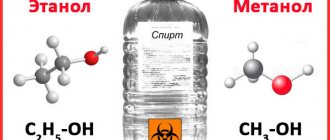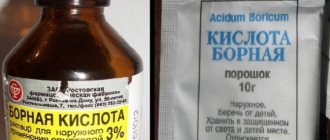Methyl alcohol (wood alcohol, methanol) is the simplest monohydric representative of the homologous series of alcohols. It is widely used as a stain remover, antifreeze and solvent.
Source: depositphotos.com
Taking methanol orally is extremely dangerous, since its oxidation in the human body produces toxic substances that cause serious poisoning, often with irreversible consequences.
What dosage of methanol is considered lethal?
Methyl alcohol is quickly absorbed into the walls of the digestive organs (less than 15 minutes) and is excreted by the body for a long time - about 5-7 days. Not only methanol in its pure form is dangerous, but also liquids containing it in small quantities. When taking doses sufficient to cause alcohol intoxication, a person exposes himself to mortal danger. This rule also applies to the widespread technical alcohol, the concentration of methanol in which is up to 12%. Complications and loss of consciousness are observed when taking 5-10 ml of methyl alcohol.
Important! What dosage of methanol is lethal? The answer to this question depends on the individual characteristics of the person and his susceptibility to the components of the toxic substance. On average, these values vary from 30 to 100 ml.
A person who takes more than 100 ml of the substance dies from cardiac arrest. With large dosages, from 200 ml, death occurs after 2-3 hours.
What kind of alcohol can you drink without endangering your health? Can I drink rubbing alcohol?
Alcohol has been known since the time of Peter I. Currently, the attitude towards this drug is twofold. One of its advantages is its use in the production of medicines. In this regard, some people are wondering what kind of alcohol they can drink without harming the body. Of course, in any case, the effect of this remedy will not be as positive as many expect.
Do you drink ethyl alcohol? Yes, but there are many cases of poisoning and more. Some people lost their sight and hearing after drinking this drink.
To prevent this from happening, you need to know the answer to the question of what kind of alcohol you can drink. And also, of course, you should understand the main components of ethanol and the nature of its origin. This article will talk about exactly this.
What is the difference between ethanol and methanol?
Drinking alcohol, does such a thing exist? Yes, and the effect of this drink on a person depends on its type and the amount drunk.
There are three main types of alcohol: ethyl, methyl and isopropyl. The last two of them are the strongest poisons. They instantly affect the lungs and nervous system. In case of poisoning, first aid must be provided immediately, as it can be fatal.
It is worth noting that ethanol and methanol are very similar to each other in their taste, color and smell. For this reason, it can be difficult to distinguish them at home.
In order to check whether it is drinking alcohol or not, it must be set on fire. By the color of the flame, you can determine the type of product. So, technical alcohol burns with a green flame, and ethyl burns with a blue flame.
In turn, methanol is used only for industrial needs and should not be sold in supermarkets. Unfortunately, nowadays there are a lot of counterfeit products, so the situations may be different. For the same reason, you should not buy a drink of dubious origin. First of all, you need to ask the seller where it was purchased.
Can I drink rubbing alcohol?
There is an opinion that this type of product should have a strength of 94%. Actually this is not true.
Typically, rubbing alcohol is about 69% ABV. It is usually used for disinfection and external use. There is absolute alcohol and its solutions. Accordingly, their strength ranges from 96% to 39%.
Is it possible to drink rubbing alcohol? It turns out that it is prescribed in a small dosage to those patients who are exhausted. It has a stimulating effect on blood circulation and breathing. In addition, as mentioned earlier, it is included in most medications.
Also, some people often ask about what alcohol to use for tinctures. So, ethanol is perfect for this. Do not forget that the product must be infused according to the instructions and always in a dark place.
Some information about other types of liquid
There are several other types of drinking alcohol: alpha and luxury. They are in a fairly high price category. This is also noted by the high quality of the products.
What alcohol is in vodka? What is used in its manufacture? There are other types of alcohol. They are of lower quality. These are basic and extra. All these high-quality types of alcohol are used in the production of vodka products.
Next we will talk about those types of liquids that should absolutely not be consumed.
Ant tincture is used as an antiseptic in the field of pharmacology. Theoretically, you can drink it, but you shouldn’t, since this product does not go through all the stages of purification that are used for alcohols in the production of vodka.
Industrial alcohol should not be consumed under any circumstances, as it contains dangerous substances. They lead to severe poisoning. This liquid is used only in enterprises.
Hydrolysis alcohol is made from wood waste and sawdust. As a rule, it is used for technical needs. When consumed internally it leads to severe poisoning. The taste of this product is salty, and there is also a chemical bitterness. Therefore, it can be distinguished from ordinary ethyl.
Cetyl alcohol is used in the field of cosmetology. It differs from other types in its high fat content. You won’t be able to consume it, although it is considered the most gentle of all for the human body.
Salicylic alcohol is made from salicylic acid and ethyl alcohol. It is used to treat the skin for various diseases. It is also used in cosmetology. If you drink it, a person will become poisoned.
Aviation alcohol is used in the operation of aircraft. It contains a large amount of metals. If this liquid is ingested, death occurs.
Thus, which alcohol you can drink from all of the above, you can easily say - ethyl. Do not abuse your health and do not experiment with drinks.
About the strength of the liquid
The highest strength of alcohol reaches 97%, but you cannot drink drinks of this type. It is also strictly forbidden to consume alcoholic beverages whose strength is higher than 49%.
This is explained by the fact that everything has a bad effect on the liver and neurons of the brain. If you drink undiluted alcohol, you can easily get a burn to the esophagus and larynx.
Tinctures sold in pharmacies are not intended for consumption by the cup; they should be used for medicinal purposes. They are made with alcohol, the strength of which is 94%.
How should you drink safely?
Ethyl alcohol does not cause as much harm to the human body as methyl. Alcoholic drinks and medicines are made from the first liquid.
Having figured out what kind of alcohol you can drink, let's look at how to do it safely. You should not use ethanol in its pure form, as this can lead to unpleasant consequences.
One of the safest methods is diluting vodka. Thanks to this, the strength is reduced, and its use will not entail virtually any side effects, except for a hangover. So, you can dilute alcohol with juice or soda.
You can also make tinctures or liqueurs from this liquid. It is not recommended to mix alcohol and other alcoholic drinks.
How can you harm your health when drinking this liquid?
Ethanol is used in the field of medicine and pharmacology, as well as in the production of vodka products. It can cause the same harm to the body as regular alcohol. This happens when it is consumed in large quantities and in an undiluted state.
The load on the liver is greater if you drink alcohol of higher strength. When drinking undiluted alcohol, you will become quickly and severely intoxicated, as well as a hangover by the morning. In addition, a person can burn the esophagus and larynx.
Each body perceives this liquid differently. For this reason, you should take precautions when drinking this drink. Ethyl alcohol should be drunk in small doses. It is not recommended to do this on an empty stomach.
Alcohol consumption negatively affects the nervous system. Namely, vision and hearing deteriorate, speech becomes unrelated.
Symptoms of poisoning
The dosage of ethyl alcohol, which can be fatal, ranges from 5 to 7 ml per kg of human weight. The more overweight people are, the more likely they are to survive drinking too much alcohol.
Signs of poisoning include nausea, cramps and dehydration. A person’s body temperature drops and the skin turns blue. The patient experiences confusion and difficulty breathing.
As mentioned earlier, alcohol abuse leads to death.
How should you choose the right drink?
Drinking diluted alcohol in moderation practically does not harm the human body, but methyl and isopropyl alcohol almost always leads to death.
Pharmakinetics and pharmacodynamics of methanol
What happens in the body when alcohol enters it?
- The overwhelming majority of methanol is concentrated in the liver, releasing deadly poisons - formic acid, formaldehyde.
- The acid-base balance in the body is disrupted.
- The organs of the visual system are affected, retinal dystonia and retinal detachment develop.
- Oxygen deficiency of cells occurs.
- The organs of the urinary system are affected, since 85% of the substance is removed by the kidneys.
The remaining 15% of methanol is excreted from the body through the respiratory system.
Effect on the body
The main place of influence of alcohol is the central nervous system. A short time after entering the stomach, the liquid is completely absorbed by the walls of the stomach and accumulates in the liver.
It is the liver cells - hepatocytes - that carry out the decomposition of alcohol into formaldehyde and formic acid. Due to the fact that the breakdown products of the substance are excreted by the kidneys, the functioning of the excretory system is disrupted.
As a result, the first substance acts on the retina of the eye, making a person completely blind. And exposure to formic acid causes intoxication, which contributes to the development of acidosis and oxygen starvation, after which symptoms of methanol poisoning appear.
Most of the methanol is excreted by the kidneys, so the excretory system is immediately paralyzed. When taken in small doses, symptoms of methyl alcohol poisoning may not be observed. However, subsequently the nervous system is seriously damaged, toxins are released that affect all internal organs, and cell function is partially blocked. There is no need to talk about what exactly the use of methanol in surrogate alcoholic beverages on an ongoing basis is fraught with.
Causes and symptoms of poisoning
Most often, people use methyl alcohol, confusing it with ethyl alcohol. Suicidal attempts to take the substance are less common. Methyl from the gastrointestinal tract is absorbed into the blood.
Signs of methanol intoxication include:
- abdominal pain;
- nausea and vomiting;
- clouding of consciousness;
- deterioration in the quality of vision;
- increased blood pressure;
- increased salivation;
- stun;
- heavy breathing;
- aggression.
In the absence of emergency help, the victim quickly loses the ability to speak.
The patient's skin becomes pale and cold. Subsequently, uncontrolled urination is observed, and the patient falls into an alcoholic coma. In severe cases of intoxication, marbling of the victim's skin is observed.
This is due to poor circulation. Death occurs due to oxygen starvation and cardiovascular failure.
Emergency assistance in case of poisoning
Emergency care for methanol poisoning is aimed at restoring the functioning of the urinary, respiratory and cardiovascular systems. Until the ambulance arrives, the victim is not given activated carbon or other medications with an adsorbing effect. The components of a poisonous drink are absorbed into the intestines faster than adsorbents can absorb them.
The situation is less dangerous if a person has consumed fatty foods before taking methanol. Fat slows down the absorption of toxins into the body.
At home, it is important to know how to rinse the stomach in case of alcohol poisoning. A solution of potassium permanganate or soda is suitable for this purpose. After the rinsing procedure, the victim needs to drink more fluid.
Another way to neutralize the harmful effects of methanol is to drink drinks with ethyl alcohol. The dose is determined at the rate of 0.5 ml per kg of weight. Ethyl alcohol is the antipode of methanol and neutralizes its negative effects on the human body. In case of poisoning, ethyl alcohol should be taken as soon as possible.
What else is recommended for rinsing the stomach in case of methyl alcohol poisoning? The procedure can be performed without using a probe. For adults, warm boiled water in an amount of 500-700 ml is suitable for cleansing. For children, use a solution of table salt. The root of the tongue is irritated with the tip of a spoon or a finger, provoking a gag reflex. Emergency assistance is provided to the victim until paramedics arrive.
The specialists then inject the patient with 4-methylperazole intravenously and give folic acid orally.
Prevention
To prevent poisoning with methyl alcohol, this substance and liquids containing it should be stored in a locked cabinet. The packaging must be clearly marked to indicate that the liquid is toxic.
In industries that use methyl alcohol, to prevent poisoning, they usually add special substances to it that either cause it to color or give it a sharp, unpleasant odor.
Methyl alcohol can be found in toxic concentrations in alcohol surrogates, as well as in counterfeit alcoholic beverages produced by handicraft. Therefore, to prevent methanol poisoning, you should buy alcoholic beverages only at official retail outlets whose activities are licensed.
Video from YouTube on the topic of the article:
Wash products and contraindications for the procedure
The main purpose of gastric lavage is to remove remaining toxic substances from the body.
The procedure is contraindicated for people who are unconscious or have inappropriate behavior. Stomach cleansing is stopped when black or red vomit appears. An effective way to cleanse the intestines of methanol is to perform an enema. For the procedure, boiled water at room temperature is used. The enema is performed several times until the patient has clear rinsing fluid.
If sorbents are used for cleansing, then preference is given to products in the form of gel or paste Enterosgel, Smecta. They have a faster therapeutic effect than drugs in tablet form. Before using sorbents, you should study the instructions for use and the required dosages. Pay attention to the release date of the product. An expired sorbent will lead to increased symptoms of intoxication.
About the strength of the liquid
The highest strength of alcohol reaches 97%, but you cannot drink drinks of this type. It is also strictly forbidden to consume alcoholic beverages whose strength is higher than 49%.
This is explained by the fact that everything has a bad effect on the liver and neurons of the brain. If you drink undiluted alcohol, you can easily get a burn to the esophagus and larynx.
Tinctures sold in pharmacies are not intended for consumption by the cup; they should be used for medicinal purposes. They are made with alcohol, the strength of which is 94%.
Gastric lavage in a hospital setting
Gastric lavage in a hospital is carried out in stages:
- First, doctors cleanse the digestive organ using a probe. Sodium bicarbonate is used as a flushing agent. The substance is also taken orally every 60 minutes.
- To weaken the effect of methanol, ethyl alcohol is administered intravenously or given orally to the patient. First, the victim is given 50 ml of alcohol, and then another 13 ml every hour.
- Mild and moderate forms of poisoning are treated with forced diuresis, and severe forms of poisoning are treated with hemodialysis (extrarenal blood purification).
In general, the treatment regimen will depend on the symptomatic picture of intoxication:
- In case of exotoxic shock, victims are administered an intravenous solution of sodium bicarbonate.
- For cerebral edema, convulsions and circulatory disorders, patients are prescribed drugs such as Piracetam, Prednisol.
- Restoration of visual functions is carried out with nicotinic acid preparations and vitamins of group E.
Consequences of methyl intoxication
Despite emergency gastric lavage measures, it is not always possible to avoid unpleasant consequences. Timely measures only minimize risks to the human body.
For a long time, the victim has vision problems, which can subsequently lead to complete blindness. The parts of the central nervous system and cells responsible for short-term memory suffer.
Patients poisoned with methyl alcohol, even with a successful outcome, experience serious complications. This applies to visual functions and the performance of the nervous system. The consequences lead the patient to loss of ability to work. For this reason, it is important to be careful about the drinks you consume.











